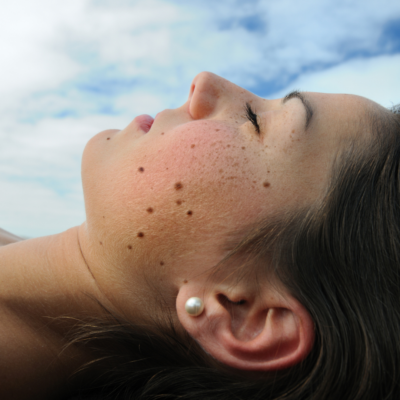
Do These 5 Things to Strengthen Your Skin Barrier
Only in the last few years has the skin barrier seen the widespread appreciation it deserves. Skinfluencers around the web and in the beauty zines can’t stop talking about the importance of maintaining a strong one. Also called the “skin moisture barrier,” it can make the difference between slack, angry, dry skin and plump, happy, supple skin.
As with all things skin, some weakening of the barrier can result from genetics or the passage of time. However, there’s still a lot you can do — and avoid — to keep yours healthy and strong.
What Is the Skin Barrier?
The two top levels of the epidermis comprise your skin’s natural barrier. The lower one is called the stratum corneum. It’s composed of 15 to 20 layers of dead skin cells, along with ceramides and free fatty acids including cholesterol. The surface level is a thin, mildly acidic coating of sebum and sweat, called the “sebum barrier” or “acid mantle.” As a whole, your skin barrier protects deeper, living epidermal cells by locking out destructive pathogens, allergens, pollution and other free radicals, while sealing in moisture.
Accordingly, a healthy skin barrier is key to keeping your skin plump, springy and youthful. Some barrier-weakening factors, like age, genetics and skin disease (e.g., rosacea, acne, eczema), are largely out of your control. However, there are five measures you can take to ensure skin-barrier integrity.
1. Assess whether your barrier is damaged.
When your skin barrier is healthy, its mantel is intact and acidic, and the cells of the stratum corneum are organized into a neat brick-and-mortar pattern with ceramides and fats acting as the mortar. When the barrier has a compromised seal and damaged, disorganized cells, moisture escapes more easily. A weakened barrier also leaves the underlying living cells more susceptible to injury and reduced function.
While other skin issues could be to blame, any of the following may be tipping you off to barrier damage:
- Dryness, tightness
- Flaking or peeling
- Redness, inflammation
- Sensitivity, reactiveness
- Rough texture, dullness
If you have acne or eczema, you may notice them looking worse. Without a strong barrier, signs of aging can begin to show and worsen.
If you suspect you have a weakened barrier, or any other skin issues for that matter, see a trusted board-certified dermatologist. Ask them to assess your barrier function, in part by measuring transepidermal water loss (TEWL). Once you know your skin barrier needs attention, take comfort in knowing that you have options for building it back up.
2. Avoid practices that harm your barrier.
You know that squeaky clean feeling your face gets after washing? Well, you shouldn’t have it! It’s one sign that you may be throwing off your pH, stripping your acid mantle and harming your barrier. Take a look at your skincare products and habits. Check for major offenders against barrier health, such as:
- Harsh soaps, astringents and detergents
- Water that’s too hot
- Potentially irritating ingredients including SLS, fragrance or silicones
- High-concentration actives, like vitamin C or retinoids (eg, retinol, Retin-A) before you’ve built up tolerance
- Using too many products or changing often
- Overly intense exfoliation, skin peels
Cleansing and exfoliation are the two skincare steps most likely to cause damage to your barrier. Take an extra gentle approach, opting for the mildest products that still do the job. Forgo scrubs and rough buffing tools, and use a chemical exfoliant product instead. A glycolic cleanser with soothing and antioxidant ingredients is a good place to start. Alternatively, you could try a product like the AHA/BHA Exfoliating Face Wash, or a wash with lactic acid. Start with a gentle formula and work your way up. If you feel a burning sensation, the product is too strong for your current tolerance level.
If you’re a fan of peels and exfoliating treatments that go deeper, entrust your skin to one of our licensed clinical aestheticians. They can help you find a way to shed dull skin and stimulate new cell turnover, while keeping your barrier healthy.
3. Make skin-health lifestyle choices.
Anything you do that keeps your skin healthy and strong will have the same effect on your skin barrier. After all, the barrier is part of your skin! Stay hydrated, exercise for good circulation, and eat nutritious foods rich in healthy oils, minerals and antioxidants.
On the skin barrier’s list of enemies to avoid are:
- Too much heat, cold, wind or sun
- High quantities of alcohol or caffeine
- Smoking
- Overindulgence in red meat or highly processed foods
- Long-term use of medications, such as blood pressure drugs, statins and antihistamines
Fortunately, avoiding most of these practices that will also keep you looking and feeling amazing overall!
4. Use barrier-fortifying products.
Healing a damaged barrier takes time and dedication, so why not use skincare that helps you avoid damage in the first place? Be on the lookout for the growing number of products designed with barrier strength in mind.
Some are easy to spot because they tell you in the name. An excellent example is Lipid Barrier Cream, which mimics mantel sebum and the “mortar” in your stratum corneum. It reinforces your skin’s barrier with a combination of ceramides, cholesterol and fatty acids including squalane. It then goes further to offer protection using antioxidants like niacinamide (vitamin B3), resveratrol and green tea polyphenols, and it gives moisture a boost with hyaluronic acid.
Some products that reinforce your skin barrier may not call it out in the name. Look for hints like “locks in moisture”, “prevents transepidermal water loss (TEWL)” or “preserves your skin’s natural pH.” Opt only for products your skin accepts calmly. Otherwise, you could do more harm than good.
5. Damaged barrier? Choose healing products.
When your skin moisture barrier has sustained breaches and other damage, fortification isn’t the only name of the game. You should also do what you can to help it heal. This means first desisting from activities that threaten your barrier, like overly aggressive exfoliation or sun exposure without an effective 30+ SPF sunscreen.
Next, give your skin protective, nourishing and healing ingredients that aid in repair. Bio-Therapy Phyto Restorative Cream seriously bolsters your skin’s defensive seal and fosters regeneration. Like your skin, it contains ceramides, squalane, hyaluronic acid and phytosphingosine, plus rejuvenating peptides and skin-saving antioxidants. If it’s your neck that needs recovery, Neck Repair Firming and Lift also mimics your skin’s natural barrier and offers antioxidants and calming, anti-aging ingredients like LACCE. In addition, it speeds healing by boosting oxygen with LYCD (also called Biodyne). The skin in the eye area needs similar care in order to mend but, of course, in a gentler product. Enriched Retinol Eye Repair smooths wrinkles and meets the needs of a damaged barrier in this delicate area, while further boosting recovery with arnica.
Barrier restoration usually takes about four weeks, longer in cases of more extreme damage or after procedures like deep peels and laser resurfacing. Be patient. It’s worth it.
Get the Balance Right
It can be tricky to find a balance between, on the one hand, exfoliation or ingredients like retinoids, and on the other hand, keeping your moisture barrier healthy. And repairing a damaged barrier can be even more challenging.
Work with an experienced skin specialist or board-certified dermatologist to assess your skin for barrier damage as well as underlying skin ailments. They can help make sure you’re on the right path to happy, resilient skin that looks more youthful, hydrated and glowing.
Individual results may vary and are not guaranteed.



 / 291 Reviews
/ 291 Reviews